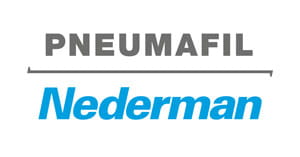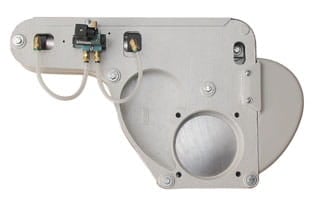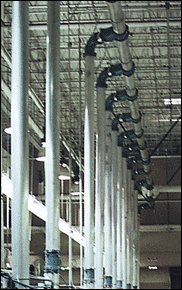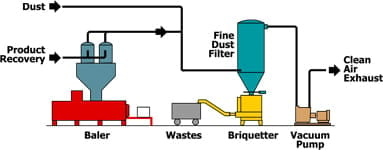Abington originated high vacuum / pneumatic conveying technology for textile waste control. Now Abington industrial vacuum systems are used in facilities manufacturing a wide variety of products

Abington originated high vacuum / pneumatic conveying technology for textile waste control. Now Abington industrial vacuum systems are used in facilities manufacturing a wide variety of products including:
- Fiberglass
- Carpet
- Textiles
- Nonwoven Textiles
- Golf Balls
- Plastic Flim
- Extruded Fibers
- Paper trim
- Concrete
The Abington vacuum system is designed to efficiently recover valuable product and collect industrial waste such as trim, fiber, dust, and plastic scraps from all areas of the plant. Material is pneumatically conveyed to a central location for disposal or further use. The basic system consists of three main components:
- Manual and automatic plant inlets for waste collection
- Aluminum tubing for conveying the waste material
- Centralized waste room equipment, including vacuum pumps, primary and secondary separators, waste receptacles, and controls
Plant Inlets

The typical Abington industrial vacuum system makes use of two types of inlets: manually controlled and automatically controlled.
Manual inlets include hoses and floor sweep stations. These are used for general housekeeping, such as cleaning around and under production machinery. Use of manual vacuum stations can reduce the expense and contamination caused by cleaning with compressed air and contributes to a healthy work environment.
These inlets can also evacuate and clean filter bags used to collect trim wastes and bulk fibers collected from napping and shearing operations. The inlet valves are opened according to a predetermined timing schedule controlled by a programmable controller.
Abington central vacuum systems outperform other vacuum systems designed primarily for housekeeping use due largely to the design of our automatic nozzles, which can reliably collect dust wherever it accumulates.
Conveyance Tubing

Abington industrial vacuum systems incorporate small diameter aluminum tubing for conveying waste from the inlets to the central station. The tubes take up very little space and can be installed overhead or under the floor. Features include:
- Tubes are grounded to prevent static build-up
- Tube fittings are directional with smooth interior surfaces for better material flow
- Rubber seals are used at all fittings to prevent vacuum leaks
Such attention to detail is one of the reasons why an Abington waste control system provides long term, efficient, trouble-free operation.
Central Waste Room Equipment

The central waste room is the heart of an Abington industrial vacuum system. A multi-stage vacuum system using centrifugal exhausters draws the wastes to the room. This type system provides:
- Low operating sound levels
- High energy efficiency
- Tolerance to dust
- High levels of vacuum (8 - 12 inches of Hg) without special controls even when multiple inlets are open
- Capacity for considerable new expansion
The wastes arrive in two forms: bulky fibrous wastes collected from production equipment, automatic filter bags, and manual inlets, and stripper dust from plant filtration systems.
Fiber wastes are fed into twin primary separator receivers with automatic discharge. This arrangement allows continuous operation because one receiver is always on-line while the other is emptying into a waste receptacle. Separator screens are self-cleaned by a patented rotating compressed air mechanism. The screens can be easily removed if required for maintenance.
The Abington supplied baler (pictured) is a flexible and convenient waste receptacle. Different models are available, producing bales weighing 500 - 750 lbs. Standard size bales are made in the horizontal baler for lay-down recycling, blending, storage for future use, resale, or disposal. Automatic and semi-automatic models are available including vertical units for bailing wire ties, bale covers, and other purposes.
Stripper dust and dust not captured by the primary separator are fed to a Fine Dust Filter (pictured). This is a self-cleaning bag filter that incorporates centrifugal action to separate out heavier particles while collecting fine dust on the bags. The bags are cleaned by compressed air back pulses. Wastes collect in a hopper which is automatically emptied through a valving system to a Briquetter, Screw Compactor, or plastic bag.
Waste room and mill automatic valve timing and functions are controlled by an Abington programmable controller (pictured). Reliable and flexible, these controls can accommodate future system expansion and sequence changes. Manual override and key switches permit fine tuning for anticipated variations and servicing. Alarm functions can be built in including fire detection and extinguishing routines. Special cycles can manage heavy loads at selected automatic pick-up stations.